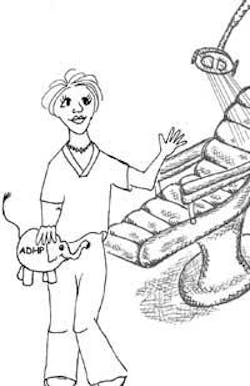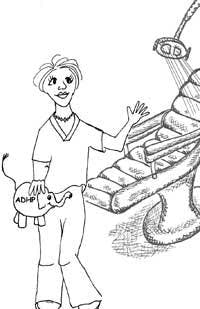Walking around an elephant
No couple in American history has fascinated me more than Eleanor and Franklin D. Roosevelt. Years ago, I used to ask my friends to make the drive from my parents’ home in New Jersey to FDR’s presidential library and museum in Hyde Park, N.Y.
My interest in Eleanor and Franklin began with a book that I read as a teenager called “Eleanor and Franklin” by Joseph P. Lash. Eleanor, who was born in 1884, was a complex character, and a woman who believed passionately in her right to self-identity, even though she lived in a time when a woman’s place was in the home. Over time, faced with daunting obstacles such as a prominent husband who was having an affair with her social secretary and an overbearing mother-in-law, Eleanor never gave up on life and continued to challenge the status quo, questioning what was acceptable and what is possible, especially in the area of women’s rights.
In one of her first speeches to the League of Women Voters, Eleanor is quoted as saying: “I am reminded of what someone once said about looking at an elephant. It is impossible to ever see an entire elephant from one place - you have to walk around it. If our elected leaders are to be truly effective, they must learn to look beyond what is in front of them.”
As we begin a new year and face continuing challenges to our profession by organized dentistry, which wishes to restrict dental hygiene practice, we are counting on our leaders to display courageous vision in moving our profession forward to a time when we will become full-fledged partners in the delivery of oral health care. Our leaders will be faced with difficult decisions concerning the education and emergence of the advanced dental hygiene practitioner (ADHP), and we must remain vigilant in the pursuit of our goals. As preventive therapists, we must look beyond what is in front of us in organized dentistry and work to improve the oral healthcare of all Americans, not just the insured and the rich.
However, as the ADHA defines the new ADHP position, one thing is clear: Without support for the poor and disabled from states and our federal government, those who need our services most won’t be able to afford them. It is naive to think that the underserved will pay cash for our services when they can barely settle their monthly bills.
I recently read an excellent article in New Yorker magazine on the failed U.S. health-care system.1 The article drives the message home (loud and clear) that America’s health care is driven by policy. The thinking is that unless an individual pays out-of-pocket for care, the care delivered is unappreciated and overused. In fact, just the opposite line of thinking turns out to be true for poor people. The more the poor are asked to chip in for health care, the less health care they use.1
Besides sealants, simple restorations, extractions, and routine dental hygiene care, what periodontal services can ADHPs offer the uninsured in our great United States? In walking around the elephant, so to speak, let’s peer into a crystal ball and try to predict future periodontal therapy for these deserving citizens. Let’s take a look at what’s next for hygienists who are committed to advancing the role of the dental hygiene clinician in periodontal therapy as an ADHP.
Scaling and root planing (SRP) is not passé but an important component of periodontal therapy. In Sweden, Axelsson et al. demonstrated that preventive dental treatment which included scaling and root planing (SRP) as needed, coupled with a high standard of personal oral hygiene, resulted in improved gingival and periodontal health over a 30-year period.2 Needs-related SRP removes bacteria nonspecifically and in proportion to their initial numbers.3 So why is it considered important to reduce the microbial load? According to our present-day understanding of the perils of local and systemic inflammation, microbial load reduction reduces the effect of the body’s inflammatory response on individuals who are at greater risk of developing periodontitis. Definitive debridement, oftentimes coupled with local or systemic antibiotic therapy and/or host-modulating agents such as 20 mg of doxycycline, is strongly recommended for those individuals who are already ravaged by immunocompromising or systemic diseases, such as those with poorly controlled diabetes or respiratory diseases. According to Lamster, the most direct association between periodontalinfection and systemic disease is seen between periodontitis and respiratory diseases.3 Those individuals with periodontal infection, particularly in the elderly population, are at increased risk for aspiration pneumonia and chronic obstructive pulmonary disease.3 The importance of providing adequate oral healthcare to the elderly and infirm by ADHPs cannot be overemphasized.
Community-oriented primary health-care settings provide opportunities for interdisciplinary collaborative health-care teams to focus on host modulation, too. For example, adults with diabetes need to be counseled for risk reduction since the various complications of diabetes (including periodontitis) can be present without signs of disease. Risk counseling for this disease is paramount but sometimes difficult for people to accept, since they might not perceive themselves to be at risk. A written survey conducted at a Diabetes Expo in Atlanta in 2005 showed that a majority of adults with type-1 and type-2 diabetes did not recognize an increased risk for periodontitis for those individuals with poor glycemic control.4
Smoking cessation strategies for youth and adults should be an essential component of ADHP care and, much too often, these services are relegated to the nursing profession. There is absolutely no doubt among periodontal researchers worldwide that smoking, by itself, is a major risk factor for periodontal disease. Obesity and diabetes combined with smoking further affect host immunity and all three factors may decrease blood flow in the periodontium, thus promoting the development of periodontitis.5
Using best available evidence, ADHPs should have significant input into designing anti-infective, host-modulating, nonsurgical periodontal protocols that are practical and cost-effective. Ongoing and frequent educational sessions in self-diagnosis and self-care will be essential for patients, and ADHPs will need to accept the challenge of research as our profession continues to enlarge its body of scientific knowledge in dealing with this new and unprecedented American oral healthcare delivery system.
Cigarette smoking is the leading cause of illness and premature death in the U.S., claiming over 400,000 lives a year. The various self-help materials don’t help very much, but individual and group counseling increases the success rates for smoking cessation. Effective communication with patients coupled with problem-solving approaches to counseling can make a difference. Social support is essential, too, and ADHPs who practice in community health centers that strengthen social ties by building coalitions with nongovernmental and governmental agencies will be in the forefront of creating a more successful U.S. health-care system.
Until the United States decides to provide health care for the 40 million Americans who lack health insurance and who cut across lines of race, class, and educational attainment, it’s unlikely that oral health care will become a priority for the chronically ill and those that are fast losing middle class respectability. ADHPs can be most effective, however, in underserved areas where primary health care is comprehensive, affordable, and with a focus on health promotion and prevention.
There are many in U.S. society who feel that the U.S. health-care system has created a subset or “caste” of people who look different and suffer in ways that others do not. A couple of Harvard researchers who have studied uninsured Americans and collected their stories, reported that the most common complaint they heard was about teeth.1 They interviewed people with rotting front teeth, individuals who kept their mouths closed while talking, and others who actually pulled out their own diseased teeth with pliers. To them, dentistry is a luxury and they long for the day when teeth will become an American health-care priority.
In my mind, I keep returning to the earliest days of our profession when dental hygienists worked not only in private practices but also in public and private institutions under “general” versus “direct” supervision. History set a precedent for community health service by hygienists, but America’s privatized health-care system, along with organized dentistry’s attempts to control us, have all but snuffed us out, especially in community-oriented primary health-care centers. Are we ready to accept the many challenges that present us as we move forward with our ADHP vision for the future? “Where there’s a will, there’s a way,” and success will come eventually if our elected leaders show fortitude and persistence in the pursuit of our goals. As Americans, we share a heritage of courage and compassion. Let’s walk with the poor and disadvantaged and show the rest of the world that we truly care.
References
1. Gladwell M. The moral hazard myth. New Yorker 2005; 44-49.
2. Axelsson P et al. The long-term effect of a plaque control program on tooth mortality, caries and periodontal disease in adults. J of Clin Periodontol 2004; 31: 749-757.
3. Lamster IB, Lalla E. Periodontal medicine - changing the face of dental care. Dimensions of Dental Hygiene. April 2004.
4. Slim LH, Thomas C. Research report presented at the 2005 Centers for Disease Control and Prevention (CDC) Diabetes Translation Conference in Miami, Fla.
5. Nishida N et al. Determination of smoking and obesity as periodontitis risks using the classification and regression tree method. J of Periodontol 2005; 76(6): 923-928.

